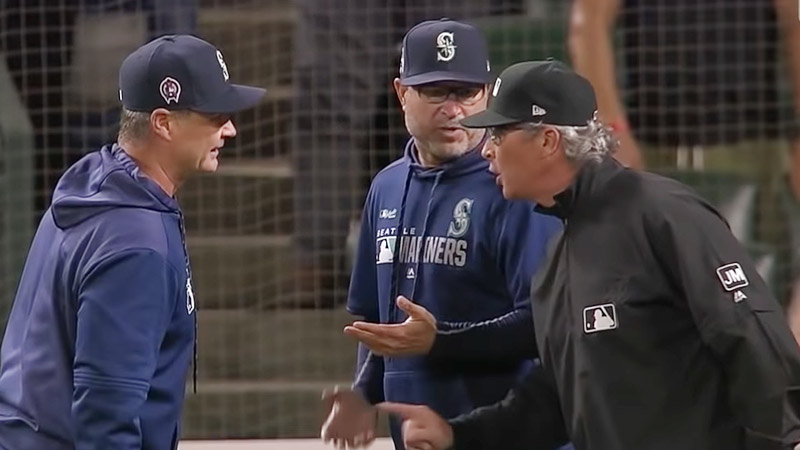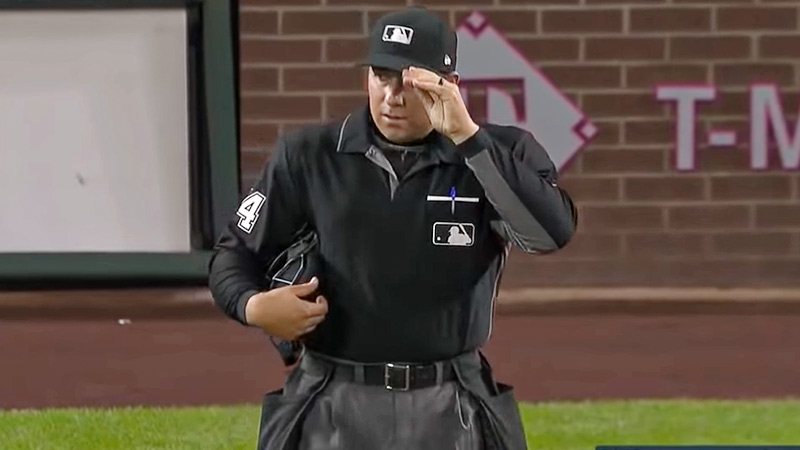Baseball is a sport steeped in tradition and unique terminology. One such intriguing term is “blue,” often used to refer to baseball umpires.
Have you ever wondered why umpires are called “blue”?
In this article, we will delve into the origins of this term and explore its significance in identifying the men and women who officiate the game. Let’s get into the body of this post now.
Why are baseball umpires called blue?
Baseball umpires are called “blue” due to the historical association between police officers and the color of their uniform, which is often blue.
The term gradually extended to umpires who also wear blue uniforms, becoming a concise and recognizable way to identify them in the sport.
Origin of the Term
The term “blue” used to refer to umpires in baseball finds its roots in the late 19th century. It emerged from the popular practice of referring to a police officer as a “bluecoat” or simply a “blue” due to the color of their uniform.
The connection between law enforcement and the color blue gradually extended to umpires in baseball, who also donned blue uniforms.
This association led to the adoption of the term “blue” to identify these officials in the sport. Over time, this term became deeply ingrained in the lexicon of baseball.
Significance in Identifying an Umpire
The use of the term “blue” to identify an umpire serves various purposes within the context of the game. Firstly, it acts as a concise and recognizable way to refer to these individuals during the course of a baseball game.
The use of the term “blue” to identify an umpire in baseball holds several significant purposes within the context of the game. Let’s explore them in detail:
Concise and Recognizable Identification
The term “blue” serves as a concise and recognizable way to refer to umpires during a baseball game.
With a single word, it instantly evokes the image of an umpire in the minds of players, coaches, and fans. This quick identification helps maintain the flow of the game, allowing for effective communication and decision-making.
Distinguishing Umpires from Others
In the dynamic and fast-paced environment of baseball, where multiple individuals occupy the field, the use of the term “blue” helps distinguish umpires from other participants.
It creates a clear division between those actively participating in the game, such as players and coaches, and those entrusted with the officiating duties. This distinction ensures that the umpires’ focus remains on maintaining order, making fair judgments, and resolving conflicts.
Maintaining Authority and Impartiality
By using the term “blue” to identify umpires, it reinforces their authority and impartiality in making critical decisions. This separation between the players and coaches helps minimize potential biases and conflicts of interest.
Umpires must make unbiased judgments based on the rules of the game, and the distinct identification as “blue” reinforces their role as neutral arbiters.

Historical and Cultural Significance
The association between umpires and the color blue carries historical and cultural significance. The link between umpires and law enforcement officers, who often wear blue uniforms, adds depth to the term’s usage.
This connection reflects the authority and respect attributed to both professions. The visual similarity between the uniforms of police officers and umpires, both featuring shades of blue, further strengthens the cultural association.
How did the Uniform of an Umpire Evolve?
The evolution of the uniform for baseball umpires parallels the growth and professionalization of the sport itself. Initially, umpires did not have a standardized uniform and would officiate games wearing their regular attire.
However, as baseball gained popularity and the need for a distinct and recognizable uniform for umpires became apparent, significant changes in their attire took place.
Distinction through Dark-Colored Suits or Coats
In the late 19th century, umpires began to wear dark-colored suits or coats to distinguish themselves from the players on the field. The choice of dark attire allowed for a clear visual contrast, making it easier for everyone involved to identify the officials.
This initial uniform choice also aligned with the tradition of referring to police officers as “blue,” further reinforcing the connection between umpires and the color.
Transition to Black Uniforms
As baseball continued to evolve, so did the uniform of umpires. In the early 20th century, umpires transitioned from dark-colored suits to wearing black suits or coats.
The black uniform became synonymous with the role of umpires and conveyed a sense of authority and seriousness. It emphasized their position as impartial arbiters responsible for making important decisions during the game.
Standardized Uniforms
In more recent years, umpires have adopted standardized uniforms that enhance their visibility and identification on the field. These uniforms typically consist of a navy blue or black shirt, matching pants, shoes, and protective gear.
The inclusion of protective gear, such as chest protectors, shin guards, masks, and helmets, ensures the safety of the umpires while they perform their duties.
The standardized uniforms often feature the official logo of the league they officiate for, further establishing their authority and affiliation.
Umpires’ numbers are prominently displayed on their uniforms, making it easier for players, coaches, and fans to identify them during the game.
The uniform not only serves a practical purpose but also represents the professionalism and integrity associated with the role of an umpire.
The Pop Culture in the Context of an Umpire’s Uniform
The uniform of a baseball umpire has not only served practical purposes on the field but has also transcended the boundaries of the game and found its place in pop culture.

Here are some key points to consider regarding the pop culture significance of an umpire’s uniform:
Portrayals in Media
The distinct appearance of umpires in their dark-colored attire has been featured in various forms of media, including movies, television shows, and cartoons.
Umpires are often depicted as authoritative figures who make crucial decisions, adding tension and drama to the storylines. These portrayals have contributed to the iconic representation of umpires in pop culture.
Symbol of Authority
The umpire’s uniform has become a symbol of authority and impartiality within the game of baseball.
The stark contrast between the dark-colored uniform and the vibrant colors of the playing field and team jerseys visually emphasizes the umpire’s role as the ultimate decision-maker.
This symbolism has further solidified the image of umpires as authoritative figures in the world of baseball.
Nostalgia and Excitement
For baseball fans, the sight of an umpire in their distinctive uniform instantly evokes feelings of nostalgia and excitement.
The uniform represents the traditions and history of the sport, reminding fans of the countless memorable moments witnessed on the diamond.
It serves as a visual cue, connecting fans to the rich heritage of baseball and igniting their passion for the game.
Cultural Significance
Beyond its role in the sport, the umpire’s uniform holds cultural significance. It has become an iconic symbol associated with the essence of baseball.
The uniform represents the values of fairness, integrity, and respect that are deeply ingrained in the sport’s ethos. It serves as a reminder of the long-standing legacy and enduring popularity of baseball as a cultural phenomenon.
Merchandise and Fan Apparel
The popularity of baseball and the unique visual appeal of the umpire’s uniform have led to the creation of merchandise and fan apparel. Fans can find various items featuring umpire-inspired designs, including t-shirts, hats, and collectibles.
These products allow fans to display their love for the game and pay homage to the umpires who play a vital role in ensuring the integrity of baseball.
FAQs
Why are baseball umpires dressed in dark-colored uniforms?
The use of dark-colored uniforms for umpires helps create a visual contrast between them and the players on the field, making it easier for everyone involved to identify the officials.
Can umpires choose the color of their uniform?
Umpires typically adhere to a standardized uniform code set by the league or organization they officiate for. This code specifies the colors, styles, and logos to be worn by umpires during games.
Do umpires wear any protective gear?
Yes, umpires wear protective gear such as chest protectors, shin guards, masks, and helmets to safeguard themselves from potential injuries caused by foul balls or collisions.
Are there any variations in umpire uniforms across different leagues or levels of baseball?
While there may be slight variations in uniform designs and logos, the basic elements of an umpire’s uniform remain consistent across different leagues and levels of baseball to maintain a cohesive and recognizable appearance.
Can umpires wear accessories or personal items with their uniform?
Umpires are generally not allowed to wear accessories or personal items that could interfere with their duties or create distractions on the field. The focus is on maintaining a professional and standardized appearance.
End Call
The term “blue” used to refer to baseball umpires has its origins in the association between law enforcement officers and the color of their uniforms.
It has become a concise and recognizable way to identify these officials during games, helping to maintain their authority and distinguish them from players and coaches.
The evolution of the umpire’s uniform further solidified this connection, with dark-colored attire becoming synonymous with their role.
The uniform not only serves practical purposes but also carries cultural significance and nostalgia in the world of baseball.
It reminds us of the importance of these impartial individuals in ensuring fair play and upholding the rules of the game. Thanks for your support.







